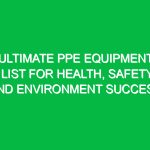Welcome to Our Toolbox Talk
Hello team! Today, we are gathering for our Toolbox Talk to discuss an essential aspect of our work: Lifting and Rigging. As you know, lifting operations are a routine part of our tasks, but they come with significant risks if not handled correctly. In this talk, we will cover critical tips, best practices, and Safety considerations that are vital for ensuring a safe working Environment. The goal is to equip you with the knowledge to perform lifting operations safely and efficiently. Let’s dive in!
Understanding Lifting and Rigging
Lifting and Rigging refers to the techniques and equipment used to lift, move, and secure loads. This includes the use of cranes, hoists, slings, and other rigging hardware. It’s crucial that everyone involved understands the various components and their appropriate applications. Each piece of equipment has a specific purpose and load capacity, which we must respect to avoid accidents.
The Importance of Safety in Lifting Operations
When we think about lifting operations, we often focus on the task itself. However, safety must always be the priority. According to the Occupational Safety and Health Administration (OSHA), improper lifting can lead to serious injuries, including fractures, sprains, and even fatalities. By prioritizing safety in our lifting and rigging processes, we not only protect ourselves but also our coworkers and the integrity of our operations.
Common Hazards in Lifting and Rigging
Before we discuss the Best Practices for lifting and rigging, let’s identify some common Hazards associated with these operations:
- Overloading: Exceeding the load capacity of lifting equipment can lead to equipment failure.
- Improper Slings: Using the wrong type or size of sling can compromise load stability.
- Environmental Factors: Wind, rain, and uneven surfaces can affect lifting operations.
- Inadequate Training: Lack of knowledge about lifting and rigging techniques can lead to errors.
- Failure to Inspect Equipment: Not checking equipment before use can result in using defective gear.
Best Practices for Safe Lifting and Rigging
Let’s go over some Best Practices that will help ensure safety during lifting and rigging operations:
1. Proper Training and Certification
All employees involved in lifting and rigging must receive proper training and certification. Training should cover the following:
- Understanding load limits and how to calculate them.
- Identifying the right equipment for specific tasks.
- Recognizing potential hazards and how to mitigate them.
Regular refresher courses are also vital to keep everyone updated on best practices and safety Regulations.
2. Conduct Pre-Lift Inspections
Before commencing any lifting Operation, always conduct a thorough inspection of the lifting equipment. Check for:
- Visible signs of wear or damage on slings, hooks, and other rigging hardware.
- Proper functioning of hoists and cranes.
- Clear pathways and work areas, free from obstacles.
Documenting this inspection can also provide accountability and serve as a reference for future operations.
3. Use the Appropriate Equipment
Choosing the right lifting equipment is crucial. Each type of load requires specific rigging gear. For example:
- Use wire ropes for heavy loads.
- Choose synthetic slings for lighter loads or delicate materials.
- Ensure all equipment meets industry Standards and is rated for the specific weight being lifted.
Never attempt to modify or repair lifting equipment unless you are qualified to do so.
4. Communicate Clearly
Effective communication is key during lifting operations. Ensure that all team members understand their roles and responsibilities. Use clear signals to indicate when to lift, lower, or stop. For example, a raised hand can signify to stop lifting, while a moving hand can indicate to lift.
Establishing a communication plan before starting the lift can prevent misunderstandings and accidents.
5. Assess Environmental Conditions
Before lifting, evaluate the surrounding environment. Consider factors such as:
- Weather conditions: Wind and rain can significantly affect lifting operations.
- Ground conditions: Ensure the surface is stable and capable of supporting the load.
- Nearby personnel: Make sure the area is clear of unnecessary personnel.
Always be prepared to halt the operation if conditions change unexpectedly.
Real-Life Scenarios: Learning from Experience
To illustrate the importance of these practices, let’s consider a couple of hypothetical scenarios:
Scenario 1: The Overloaded Crane
Imagine a team is preparing to lift a heavy steel beam. They calculate the weight to be around 8,000 pounds. However, in a rush, they decide to use a crane rated for only 7,000 pounds. As they begin the lift, the crane suddenly fails, leading to a catastrophic accident.
This situation could have been avoided with proper training and proper load calculations. Always ensure that the equipment used is rated for the load you intend to lift.
Scenario 2: The Uncommunicative Crew
In another scenario, a crew is lifting a large container. The designated signaler is not clear in their communication, leading to confusion among the team. As the load is lifted, a worker on the ground does not realize it has started moving and is nearly struck.
This highlights the necessity of clear communication in lifting operations. Establishing and adhering to communication protocols can prevent accidents.
Regulations and Standards
Compliance with regulations and standards related to lifting and rigging is not just a legal obligation; it is a moral one that protects everyone on site. Key standards to be aware of include:
- osha regulations regarding lifting equipment and training.
- American National Standards Institute (ANSI) guidelines for rigging.
- Company-specific safety policies that may go beyond the minimum legal requirements.
Understanding these regulations helps to foster a culture of safety and accountability.
Engagement and Team Responsibility
As we conclude today’s Toolbox Talk, I encourage you all to ask questions and share your experiences related to lifting and rigging. Remember, safety is a team effort. Each of us plays a crucial role in maintaining a safe working environment.
In your daily operations, take the responsibility to:
- Speak up if you see unsafe practices.
- Encourage your teammates to adhere to safety protocols.
- Participate actively in safety training and discussions.
Conclusion
To wrap up, we’ve covered essential lifting and rigging tips that are crucial for ensuring safety on the job. Prioritize training, inspect equipment, communicate effectively, and always assess your environment before lifting. Remember, every lifting operation poses potential hazards, but with the right practices, we can minimize these risks.
Thank you all for your attention today. Your commitment to safety ensures that we can work efficiently and return home safe every day. Let’s keep the conversation going and continue to support each other in our efforts to maintain a safe workplace.


